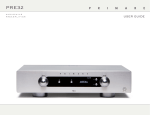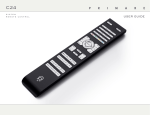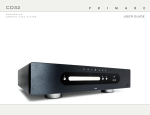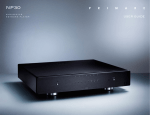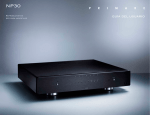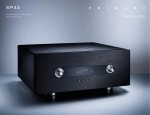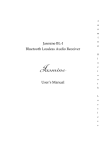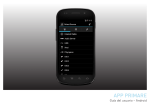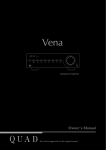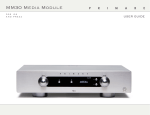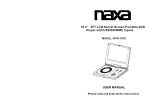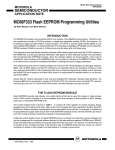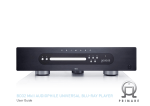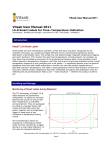Download DAC30 userguide English
Transcript
DAC30 audiophile digital-to-analogue converter user guide D A C 3 0 USER GUIDE Welcome! Welcome to the Primare DAC30! Your DAC30 is a fully balanced audiophile digitalto-analogue converter, designed to get the best quality from digital sources such as computer audio. Balanced Unbalanced analogue outputs analogue outputs IN 1 IN 2 Coax/optical digital inputs IN 3 XLR digital input USB digital Coax input digital output Power On/off D A C 3 0 USER GUIDE Getting Started Set up your DAC30 in four simple steps: 1 U n p ac k t h e D A C 3 0 Your DAC30 is supplied with the following components: • • • Mains cable. C23 remote control. Two batteries for the remote control. If any of these items are missing please contact your supplier. We recommend you retain the packaging in case you need to transport the unit at a later date. 2 Connect to a preamplifier The DAC30 is designed to be connected to an analogue preamplifier or integrated amplifier with either balanced or unbalanced inputs. Balanced outputs • If your preamplifier provides balanced inputs, for best results connect the balanced XLR outputs OUT 1 from the DAC30 to the preamplifier using high quality XLR cables. Unbalanced outputs • Otherwise connect the unbalanced outputs OUT 2 to the preamplifier using high quality RCA cables. 3 C o n n e c t INPUTS 4 Connect power You can connect up to three coax or optical digital inputs and one balanced XLR digital input to the DAC30. In addition, the USB input allows you to use the DAC30 as a digital audio output device for a computer. • Digital coax or optical inputs • Connect the inputs IN 1 to IN 3 to digital sources with optical outputs, using either TOSlink or coax digital cables. Digital XLR input • Connect input IN 4 to a digital source with a balanced XLR output, using an XLR cable. USB input • Connect a Windows PC or Macintosh USB port to IN 5 on the DAC30 using a USB A to USB B cable. PC: Windows XP/SP2 or later is required. You need to install the Primare xmos audio driver, available on primare.net. Plug one end of the mains cable supplied with the DAC30 into the power connector on the back panel, and connect the other end to a wall socket. If this cable is not suitable for your power outlets please contact your supplier for an alternative cable. Note: See Phase, page 6, for information about getting the best sound from your DAC30. • WARNING: Always disconnect the DAC30 from the mains power before connecting or disconnecting any cables. Switch on the DAC30, using the switch on the back panel. The standby indicator will light up on the front panel. To switch on from standby • Press O on the front panel or remote control. Mac: OSX 10.4 or later is recommended. No driver is required. The indicators on the front panel will show the currently selected digital input and sample rate. The DAC30 will then appear as a sound output device called XMOS USB Audio 2.0 in the Sound control panel (PC) or Sound system preferences panel (Mac). Press O again to switch to standby. D A C 3 0 USER GUIDE Using the DAC30 This page explains how to operate your DAC30, using the functions available from the front panel or C23 remote control. Front panel controls Standby O Switches the DAC30 to standby, or switches it on from standby. Selector Steps between the inputs. Selecting a source The DAC30 provides a choice of five inputs, IN1 to IN5. To select a source • Press the SELECTOR button until the source is indicated on the front panel display. • Blanking the i n d i ca t o r s To blank the front panel indicators • • Press the DIM button on the remote control. Press the DIM button again to restore the indicators. Alternatively, press the A or V buttons on the remote control to step between sources, or press one of the buttons 1 to 5 on the remote control to select the corresponding source directly. The DAC30 provides an audiophile relaycontrolled mute circuit to avoid clicks when changing source. D A C 3 0 USER GUIDE Using the remote control Switch on/off This page explains how to use the C24 remote control to operate the DAC30, and how to fit the batteries into the remote control. Select an input F i t t i n g t h e ba t t e r i e s Before using the remote control you need to insert the two button cells supplied with the C24. • Open the cover on the back of the remote control by pressing the tab gently: Select next input Select DAC30 mode • Insert the two batteries, positive side uppermost: Select previous input Increase the volume Decrease the volume + CR2 02 M BATT5 ERY 3V + 5 Y 202 TER CR BAT M HIU 3V LITHIU LIT Control the CD player • Replace the cover and push until it clips into place. Note: Replace only with 3V button cells type CR2025 or equivalent. When disposing of old batteries please be considerate to the environment. Blank the front-panel indicators D A C 3 0 USER GUIDE Technical specification Additional information The DAC30 offers the processing engine of the celebrated Primare BD32 universal player, a high-end low-noise circuit layout, and balanced XLR outputs for connection to a high quality music system. These instructions help you get the best possible sound from your DAC30. F e at u r e s Performance Phase Burn-in 24 bit, 192kHz operation Signal to noise ratio The phase of the AC supply can make a significant difference to the sound. Your Primare will start to sound best after an initial burn-in of approximately 24 hours. Ensure that the live pin of the AC power cable is connected to the left-hand pin of the power connector, viewed from the back panel: You will notice a further smaller improvement in sound quality for at least another 3 days’ playing. Crystal DSD DAC CS4398 R-Core transformer An audiophile relay controlled mute circuit Analogue outputs Balanced outputs XLR, 4.3V. Unbalanced output 120 dB General Size 430 x 370 x 95mm (WxDxH) Colour Black or titanium Live US B Sa m p l e r a t e To take advantage of the highest 24 bit/192kHz setting offered by the DAC30 you may need to select an appropriate output setting on your computer. RCA, 4.3V. DIGIT A L I n p u t s Coax/optical inputs 3 x TOSlink or S/PDIF auto-sensing. Balanced input 1 x XLR AES/EBU. USB input 1 x USB B asynchronous. D A C 3 0 USER GUIDE Copyright and ac k n o w l e d g m e n t s Copyright © 2012-2013 Primare AB. All rights reserved. Primare AB Limstensgatan 7 21616 Limhamn Sweden http://www.primare.net Issue: DAC30/2 The information in this guide is believed to be correct as of the date of publication. However, our policy is one of continuous development and so the information is subject to change without notice, and does not represent a commitment on the part of Primare AB. Primare is a trademark of Primare AB. This guide was produced by Human-Computer Interface Ltd. http://www.interface.co.uk Safety compliance This product has been designed to meet the IEC 60065 international electrical safety standard. CAUTION RISK OF ELECTRIC SHOCK DO NOT OPEN ATTENTION RISQUE DE CHOC ELECTRIQUE NE PAS OUVRIR CAUTION: To reduce the risk of electrical shock do not remove cover (or back). No user serviceable parts inside. Refer servicing to qualified service personnel. WARNING: To reduce the risk of fire or electrical shock, do not expose this apparatus to rain or moisture. CAUTION: In Canada and the USA, to prevent electric shock, match the wide blade of the plug to the wide slot in the socket and insert the plug fully into the socket. This product is designed and manufactured to meet strict quality and safety standards. However, you should be aware of the following installation and operation precautions. 1. Take heed of warnings & instructions You should read all the safety and operating instructions before operating this appliance. Retain this handbook for future reference and adhere to all warnings in the handbook or on the appliance. 2. Water and moisture The presence of electricity near water can be dangerous. Do not use the appliance near water – for example next to a bathtub, washbowl, kitchen sink, in a wet basement or near a swimming pool, etc. 3. Object or liquid entry Take care that objects do not fall and liquids are not spilled into the enclosure through any openings. Liquid-filled objects such as vases should not be placed on the equipment. 4.Ventilation Do not place the equipment on a bed, sofa, rug or similar soft surface, or in an enclosed bookcase or cabinet, since ventilation may be impeded. We recommend a minimum distance of 50mm around the sides and top of the appliance to provide adequate ventilation. The lightning flash with an arrowhead symbol within an equilateral triangle, is intended to alert the user to the presence of uninsulated 'dangerous voltage' within the product's enclosure that may be of sufficient magnitude to constitute a risk of electric shock to persons. The exclamation point within an equilateral triangle is intended to alert the user to the presence of important operating and maintenance (servicing) instructions in the literature accompanying the product. 5. Heat Locate the appliance away from naked flames or heat producing equipment such as radiators, stoves or other appliances (including other amplifiers) that produce heat. 6. Climate The appliance has been designed for use in moderate climates. 7. Racks and stands Only use a rack or stand that is recommended for use with audio equipment. If the equipment is on a portable rack it should be moved with great care, to avoid overturning the combination. 8. Cleaning Unplug the unit from the mains supply before cleaning. The case should normally only require a wipe with a soft, damp, lint-free cloth. Do not use paint thinners or other chemical solvents for cleaning. We do not advise the use of furniture cleaning sprays or polishes as they can cause indelible white marks if the unit is subsequently wiped with a damp cloth. 9. Power sources This appliance must be connected to a mains socket outlet using the supplied power cord. To disconnect this apparatus from power, you must disconnect the power cord. Make sure the power cord is always easily accessible. Only connect the appliance to a power supply of the type described in the operating instructions or as marked on the appliance. This is a Class 1 device and must be earthed. The power switch is a single-pole switch. When the switch is in the “Off ” position, the appliance is not completely disconnected from the main power. 10. Power-cord protection Power supply cords should be routed so that they are not likely to be walked on or pinched by items placed upon or against them, paying particular attention to cords and plugs, and the point where they exit from the appliance. 11. Grounding Ensure that the grounding means of the appliance is not defeated. 12. Power lines Locate any outdoor antenna/aerial away from power lines. 13. Non-use periods If the unit has a stand-by function, a small amount of current will continue to flow into the equipment in this mode. Unplug the power cord of the appliance from the outlet if left unused for a long period of time. 14. Abnormal smell If an abnormal smell or smoke is detected from the appliance, turn the power off immediately and unplug the unit from the wall outlet. Contact your dealer immediately. 15. Servicing You should not attempt to service the appliance beyond that described in this handbook. All other servicing should be referred to qualified service personnel. 16. Damage requiring service The appliance should be serviced by qualified service personnel when: A. the power-supply cord or the plug has been damaged, or B. objects have fallen, or liquid has spilled into the appliance, or C. the appliance has been exposed to rain, or D. the appliance does not appear to operate normally or exhibits a marked change in performance, or E. the appliance has been dropped or the enclosure damaged. the sound and vision of scandinavia p l e a s e v i s i t primare.net f o r m o r e information about our products p r i m a r e ab limstensgatan 7 21616 limhamn sweden primare.net










